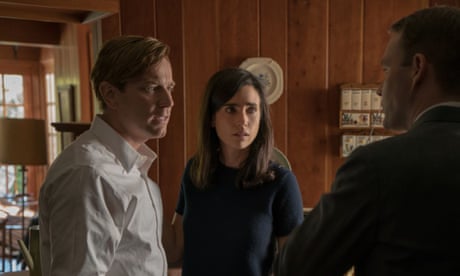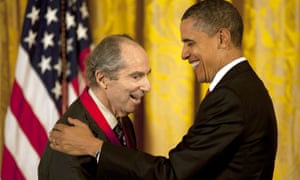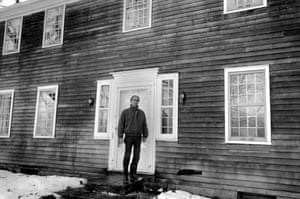Intense, exuberant, profound, Philip Roth was a towering figure of 20th-century literature. Sarah Churchwell pays tribute to the writer who died this week

Philip Roth … he liked to play devil’s advocate.
“Sheer playfulness and deadly seriousness are my closest friends,” Philip Roth once said. “The redeeming value is not social or cultural reform, or moral instruction, but comic inventiveness. Destructive, or lawless, playfulness – and for the fun of it.” Characteristically, he italicised the word inventiveness; one might say that italicised inventiveness was Roth’s stock in trade. Over a career that spanned almost 50 years, he wrote 31 books, including an early effort mischievously titled The Great American Novel (1973). Roth would have been the first to appreciate the irony of the fact that most readers regard it now as one of his least successful books.
But it was also typical of Roth to confront the question of whether he could write “the great American novel” head-on, for his literary ambitions were always confrontational. People who knew him speak often of how polite Roth was in person; on the page he is anything but. Impatience drives his best work; the mind that enters ours when we read him is mercurial, impassioned, indignant, hilarious, voluble and always interesting.
Accused of narcissism, he wrote in his chronicles of Newark both a history and a counter-history of the American 20th century. The realist novel, written in the indicative mood, tells us what the world is, and Roth could do realism, brilliantly, in novels such as his American trilogy, American Pastoral, I Married a Communist and The Human Stain. But he also created a vast literary project in the conditional, asking what the world could be in novels like The Ghost Writer, The Counterlife and Operation Shylock. In My Life As a Man he wrote, revealingly (and, as always, emphatically):
His self is to many a novelist what his own physiognomy is to a painter of portraits: the closest subject at hand demanding scrutiny, a problem for his art to solve – given the enormous obstacles to truthfulness, the artistic problem. He is not simply looking in the mirror because he is transfixed by what he sees. Rather, the artist’s success depends as much as anything on his powers of detachment, on denarcissising himself. That’s where the excitement comes in. That hard conscious work that makes it art!

Howard Jacobson: Is American Pastoral Philip Roth at his best?
Roth’s novels are narrated through a dizzying array of fictional proxies, including the most frequently recurring Nathan Zuckerman, as well as the personas of Alex Portnoy, David Kepesh, Peter Tarnopol and Mickey Sabbath. But he also wrote five books about Philip Roth, who both was and was not a recognisable self-portrait. In Operation Shylock, a fictional real Philip Roth confronted a fictional counterfeit Philip Roth in a vertiginous game about the nature of identity. Whatever name he gave his alter egos, Roth also always gave them his caustic, searching humour, the propulsive energies of rage and an unmistakable exultation in the power of language.
In The Ghost Writer a young Nathan Zuckerman is told by an older writer that he has something much more important than a style: a voice, and not only that but a voice that starts behind his knees and reaches over his head. Young Nathan imagines being a different kind of writer: “Purity. Serenity. Simplicity. Seclusion. All one’s concentration and flamboyance and originality reserved for the gruelling, transcendent calling?” Instead, he lets fly with all his concentration and flamboyance and originality.

Barack Obama awards the Medal of Art and Humanities to Roth in 2011.
He could transition from the metafictional cartwheels of The Counterlife and Operation Shylock to the straightforward realism of The Human Stain. These are novels of ideas, conundrums, epistemology. How do we know what we think we know? Operation Shylock is built on the Cretan-liar paradox of a narrator who asserts that he is lying. How does a story reach us, who are the people to whom we listen and why? Where does moral authority reside, what is the role of the artist? Love is there, politics are always there. Roth could be beautiful, he could be heartbreaking, but he was always audacious and breathtakingly funny.
The range of his imagination across the 20th- century Jewish-American experience is sometimes underestimated. From the survival of Anne Frank to the election of President Lindbergh to the Palestinian question and Zionism, to the diaspora and the treatment of Jews in the eastern bloc, he engaged seriously and consistently with questions of antisemitism. He engaged no less seriously with literary history – James, Flaubert, Kafka, Gogol, Chekhov, Bellow, Malamud, Singer – all the while spinning out existential, psychological, philosophical, linguistic and narrative puzzles.
His fulminating humour and deft anger fused comedy and tragedy, world-weariness and nostalgia, rage and love
Roth made look easy what is very difficult: to voice the feeling of human energy. He was a virtuoso of excitement, breaking out into impassioned, wild, unruly diatribes. A writer of great intensity, of extremity, Roth was perfectly willing to pummel his reader into submission. Combustible, exuberant, ebullient, his books are propelled by words and an intensity of feeling about them. His fulminating humour and deft anger fused comedy and tragedy, world-weariness and nostalgia, rage and love, indignation and amusement, freewheeling through the swing and power of his prose. There is an impulse to caricature, to great comedic set pieces, but it was controlled by a sense of poignancy and suffering, with increasingly hard-won wisdom offered with great insight and clarity. His monologues are a performance of selves, the human comedy come alive. “The dirty little secret,” Roth once said, “is no longer sex; the dirty little secret is hatred and rage. It’s the tirade that’s taboo.” Talkativeness is nothing less in Roth than the life force itself. His books are explorations of speech as a literary performance, as the essence of the self. “I am your permission,” Zuckerman says, “your indiscretion, the key to disclosure.”
Most of the books that lay claim to being a great American novel – if not theGreat American Novel – give a sense of the infinite variety of the American experiment, while also creating the memorable individual voices that can speak for that experiment. Ishmael, Huckleberry Finn and Nick Carraway articulate a singular perspective on a plural, cacophonous society and its history. Roth takes his place in that list, without question, although his singular narrators were themselves plural, as Portnoy-Zuckerman-Roth prismatically refracted the nation, and the man, back to themselves. That is not merely an aesthetic project: it is an ethical one as well. His novels are deeply implicated in the history of their times. The second world war, the McCarthy period, the Vietnam war, the sexual revolution of the 1960s, political terrorism, Watergate, identity politics, the Clintons, the Bush years and 9/11, while with The Plot Against America he can be said to have anticipated the Trump years. In an interview, he once said: “Any satirist writing a futuristic novel who had imagined a President Reagan during the Eisenhower years would have been accused of perpetrating a piece of crude, contemptible, adolescent, anti-American wickedness, when, in fact, he would have succeeded, as prophetic sentry.”

Roth in rural Connecticut, 1990.
In Roth’s best books, the great omniscient perspective of the 19th-century American novel stands up and looks askance at the mess of the 20th century, making its wry disgust known. He was accused of self-involvement, and it is true that all of his interest in the self left little room on the page for the other. Those others were often the women after whom his characters so priapically lust, and gave rise to charges of misogyny. It is not hard to see why, but the rebarbative nature of his interest in his own identity, broadly construed as Jewish American 20th-century male, also had the unfortunate effect of occluding the moral nature of his engagement with the profound questions that drive our best literature: mortality, the nature of suffering, betrayal and loyalty, these run beneath the jokes being cracked on the surface. He liked to play devil’s advocate, and to show sympathy for the devil; he disliked false pieties and sacred cows. Those are moral stances, too. “It’s one thing to say,” he once observed, that a character “is limited or unlikable and another to say that he’s unreal, or doesn’t represent something real.”
If Roth preferred the symphonic, he could also do the sonata and fugue, the smaller, quieter compositions and structures, as he showed in his final books, known as the Nemeses series: Everyman, Indignation, The Humblingand Nemesis. These were lesser books, because the titanic energy and concentration was palpably ebbing. But their confrontations with age and mortality remain tremendously moving, in a minor key:
The profusion of stars told him unambiguously that he was doomed to die, and the thunder of the sea only yards away – and the nightmare of the blackest blackness beneath the frenzy of the water – made him want to run from the menace of oblivion to their cosy, lighted, underfurnished home.
In Sabbath’s Theater, Mickey Sabbath decides that he is doomed to life. “He could not fucking die. How could he leave? How could he go? Everything he hated was here.” It is impossible to read Roth across the range of his work and not realise that everything he loved was here, and captured. As he wrote in The Counterlife:
The burden isn’t either/or, consciously choosing from possibilities equally difficult and regrettable. It’s and/and/and/and/and as well. Life and: the accidental and the immutable, the elusive and the graspable, the bizarre and the predictable, the actual and the potential, all the multiplying realities, entangled, overlapping, colliding, conjoined – plus the multiplying illusions!
Amplification was his metier, the “and/and/and” a mark of human energy, of vitality and capaciousness. Roth italicised the “is,” just as he italicised “inventiveness”. The emphasis was everything.
No comments:
Post a Comment